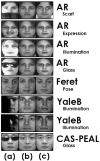AD-VAE: Adversarial Disentangling Variational Autoencoder
- PMID: 40096455
- PMCID: PMC11902370
- DOI: 10.3390/s25051574
AD-VAE: Adversarial Disentangling Variational Autoencoder
Abstract
Face recognition (FR) is a less intrusive biometrics technology with various applications, such as security, surveillance, and access control systems. FR remains challenging, especially when there is only a single image per person as a gallery dataset and when dealing with variations like pose, illumination, and occlusion. Deep learning techniques have shown promising results in recent years using VAE and GAN, with approaches such as patch-VAE, VAE-GAN for 3D Indoor Scene Synthesis, and hybrid VAE-GAN models. However, in Single Sample Per Person Face Recognition (SSPP FR), the challenge of learning robust and discriminative features that preserve the subject's identity persists. To address these issues, we propose a novel framework called AD-VAE, specifically for SSPP FR, using a combination of variational autoencoder (VAE) and Generative Adversarial Network (GAN) techniques. The proposed AD-VAE framework is designed to learn how to build representative identity-preserving prototypes from both controlled and wild datasets, effectively handling variations like pose, illumination, and occlusion. The method uses four networks: an encoder and decoder similar to VAE, a generator that receives the encoder output plus noise to generate an identity-preserving prototype, and a discriminator that operates as a multi-task network. AD-VAE outperforms all tested state-of-the-art face recognition techniques, demonstrating its robustness. The proposed framework achieves superior results on four controlled benchmark datasets-AR, E-YaleB, CAS-PEAL, and FERET-with recognition rates of 84.9%, 94.6%, 94.5%, and 96.0%, respectively, and achieves remarkable performance on the uncontrolled LFW dataset, with a recognition rate of 99.6%. The AD-VAE framework shows promising potential for future research and real-world applications.
Keywords: GAN; face recognition; single sample.
Conflict of interest statement
The authors declare no conflicts of interest.
Figures



References
-
- Lahasan B., Lutfi S.L., San-Segundo R. A survey on techniques to handle face recognition challenges: Occlusion, single sample per subject and expression. Artif. Intell. Rev. 2017;52:949–979. doi: 10.1007/s10462-017-9578-y. - DOI
-
- Liu F., Chen D., Wang F., Li Z., Xu F. Deep learning based single sample face recognition: A survey. Artif. Intell. Rev. 2023;56:2723–2748. doi: 10.1007/s10462-022-10240-2. - DOI
-
- Minaee S., Abdolrashidi A., Su H., Bennamoun M., Zhang D. Biometrics recognition using deep learning: A survey. Artif. Intell. Rev. 2023;56:8647–8695. doi: 10.1007/s10462-022-10237-x. - DOI
-
- Zhao W., Chellappa R., Phillips P.J., Rosenfeld A. Face recognition: A literature survey. ACM Comput. Surv. 2003;35:399–458. doi: 10.1145/954339.954342. - DOI
-
- Deng W., Hu J., Guo J. In Defense of Sparsity Based Face Recognition; Proceedings of the 2013 IEEE Conference on Computer Vision and Pattern Recognition; Portland, OR, USA. 23–28 June 2013; pp. 399–406.
MeSH terms
Grants and funding
LinkOut - more resources
Full Text Sources
Research Materials

